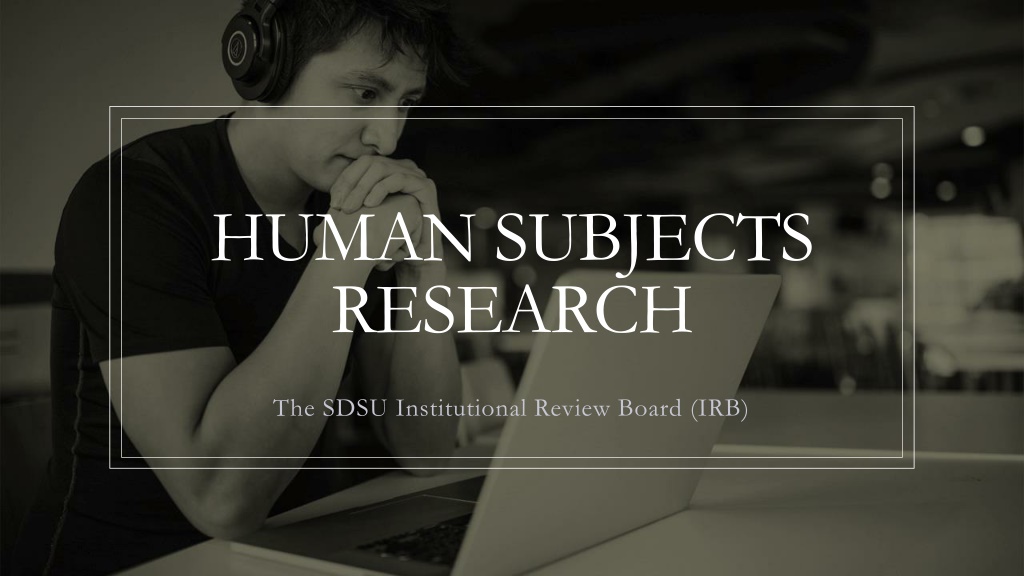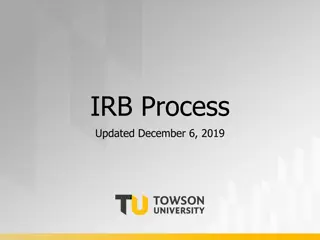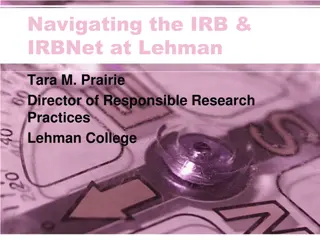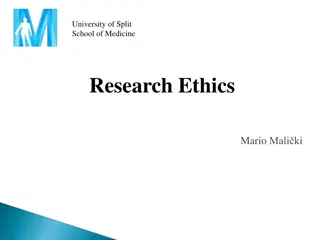Understanding Human Subjects Research at SDSU
Explore the process of conducting human subjects research at SDSU through lessons on recognizing research activities, determining involvement with human subjects, identifying common pitfalls in proposal submissions, finding IRB information, and submitting proposals. Gain insights on the importance of systematic investigation and producing generalizable knowledge, as well as common pitfalls to avoid when submitting research proposals.
Download Presentation

Please find below an Image/Link to download the presentation.
The content on the website is provided AS IS for your information and personal use only. It may not be sold, licensed, or shared on other websites without obtaining consent from the author. Download presentation by click this link. If you encounter any issues during the download, it is possible that the publisher has removed the file from their server.
E N D
Presentation Transcript
HUMAN SUBJECTS RESEARCH The SDSU Institutional Review Board (IRB)
Course Outline Lesson 2. Lesson 3. Lesson 1. Is It Research? Am I Researching Human Subjects? What are the Common Pitfalls in research proposal submissions? Lesson 4. Lesson 5. Where do I find SDSU IRB Information? How do I submit my proposal in InfoEd?
Lesson One: Is it Research? Is it a systematic investigation? Is the intent to produce generalizable knowledge? The answer must be yes to both.
Lesson One: Is it Research? The reason that the proposal must it be both a systematic investigation and designed to produce generalizable knowledge is: Systematic investigations are often used in other endeavors that are not research. Some examples: Quality Assessment/Quality Improvement Case studies
Lesson One: Is it Research? It s generalizable when The intent is to add to a corpus of theoretical knowledge within a discipline In general, it is designed to benefit those other than the research participants
Recap of Lesson One Research is both. (1)A systematic investigation. (2) Intended to produce generalizable knowledge. Intent to publish (in and of itself) research. Generally benefits those other than the participants QA/QI or case studies are not research (but are often published as QA/QI projects).
Lesson Two: Am I Researching Human Subjects? A living individual about whom an investigator conducting research: Obtains private identifiable information through interaction and uses, studies or analyzes the information Obtains, uses, studies, analyzes, or generates identifiable private information
Lesson Three: What are the Common Pitfalls? No supporting documents Faculty Advisor not included on the application. Inconsistency between the application and the supporting documents Not including all required elements of informed consent Not including human subjects training certificates for all study team members
Where do I find SDSU IRB Information? https://research.sdsu.edu/research_affairs/ human_subjects Link to CITI training o Link to general steps to submission o Link to SDSU IRB Standards and Practices o Submission deadlines o Link to forms (e.g. consent templates and checklists) o
How do I Submit My Research Proposal in InfoEd? Human Subjects Guidebook Video Guidance on SDSU IRB SharePoint
Recap Research is defined as both a systematic investigation and it s intent is to contribute to generalizable knowledge. Publication (in and of itself) Research Systematic investigations can be used in QA/QI and case studies and QA/QI or case studies are not research Defined human subject Common submission pitfalls The SDSU website is where additional information can be found. There is both a guidebook and videos to help you navigate InfoEd
Who Can I Contact? Human Subjects Regulations: Anne Dodge-Schwanz Pat Gordon InfoEd or CITI training: Justin Dean Contact information: 619-594-6622 or irb@sdsu.edu
THANK YOU! I will now answer questions that were sent to me in advance as well as and any additional questions.























